There’s No Crying in Baseball
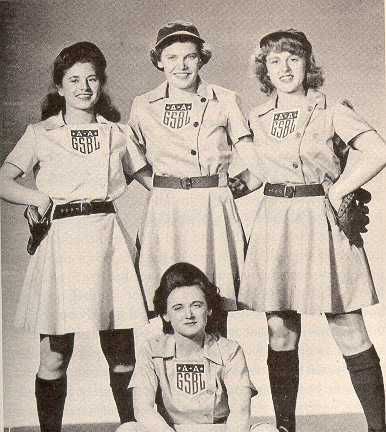
by Lynne Taylor. Published in the January/February 2015 issue of Finery.
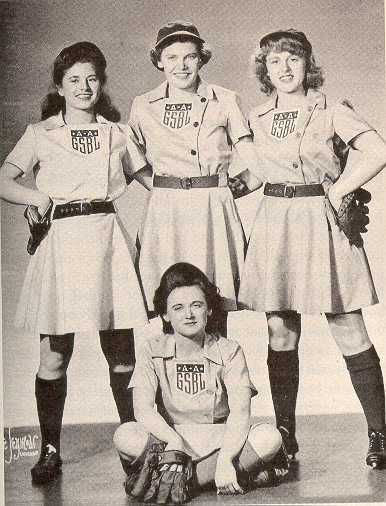
Just about everyone has seen the 1992 movie “A League of Their Own.” It stars Tom Hanks as a former professional baseball player, who becomes the coach for a women’s professional baseball team. The movie is entertaining and contains a mix of history and fancy that served to expose the world to a interesting chapter of American World War II history. The movie is based on the All American Girls Professional Baseball League (AAGPBL) started by Phillip Wrigley, owner of the Chicago Cubs. He saw that men were volunteering to go into the service and there was an active draft leaving a shortage of new pro baseball players. This lack of male players threatened to shut down the major leagues if the war continued, so he created this new women’s league. It would serve to help fill the gap and fill seats. Mr. Wrigley held tryouts in May of 1943. The league would be built on skill and ladylike behavior. “Femininity is the key note of our league,” Wrigley said. “No pants-wearing, tough-talking, female softballer will play on any of our four teams.”

In the spirit of keeping the players looking feminine, the league uniform was a cotton dress with a short skirt, satin shorts were worn underneath. This gave rise to the term “dirt in the skirt,” a favorite saying of the female players. The one piece tunic with a short flared skirt was in the style of tennis, field hockey, and figure skating uniforms of the times. A hat, belt, and knee high baseball socks completed the uniform. Each city had a different colored uniform, a league arm patch was standard on the left sleeve, and all uniforms had a round team patch that adorned center front. Teams donned a white uniform with colored accessories for home games and the full color uniform for away games.
When a player was chosen for a team she was expected to not only be a good ball player but she needed to be a good representative of her home, her country, and her team. The girls attended classes in charm and beauty and traveled with a female chaperone. Helena Rubenstein’s Beauty Salon was contracted for the first spring training and after the daily practices, the women attended the charm class. The following is a except from the charm school pamphlet given to the girls after they won a spot on a team during try-outs:
“When you become a player in the All-American Girls Baseball League you have reached the highest position that a girl can attain in this sport. The All-American Girls Baseball League is getting great public attention because it is pioneering a new sport for women. You have certain responsibilities because you too, are in the limelight. Your actions and appearance both on and off the field reflect on the whole profession. It is not only your duty to do your best to hold up the standard of this profession but to do your level best to keep others in line.
“The girls in our League are rapidly becoming the heroines of youngsters as well as grownups all over the world. People want to be able to respect their heroines at all times. The All American Girls Baseball League is attempting to establish a high standard that will make you proud that you are a player in years to come.
We hand you this manual to help guide you in your personal appearance. We ask you to follow the rules of behavior for your own good as well as that of the future success of girls’ baseball. In these few pages you will find many of the simple and brief suggestions which should prove useful to you during the busy baseball season. If you plan your days to establish an easy and simple routine, so that your meals are regular and well balanced, so that you have time for outside play and relaxation, so that you sleep at least eight hours each night, and so that your normal functions are regular, you will be on the alert, do your job well, and gain the greatest joy from living. Always remember that your mind and your body are interrelated, and you cannot neglect one without causing the other to suffer. A healthy mind and a healthy body are the true attributes of the All-American girl.”
This pamphlet was full of suggested beauty routines for before and after the games as well as clothing and wardrobe tips for on the road during the season. The girls were also given advise on other subjects like etiquette publicity. The league covered all the bases when it came to the welfare of their players. You can find more history and the complete text of the charm pamphlet at on the official AAGPBL website.

Teams consisted of fifteen players, a coach (manager), a business manager, and a women’s chaperone. In the first year there were four teams: The Rockford Peaches, The Kenosha Comets, The Racine Belles, and The South Bend Blue Sox. By 1944 it was apparent that the war was coming to an end so Phillip Wrigley withdrew his support of the league at the end of the second season. Even so the league continued and grew. At its height there were eleven teams.
Many people do not know that the league continued after the war. In fact, the league continued until 1954. All in all over 600 women were on teams during the league’s existence. The league closed down for a number of reasons but the AAGPBL was a ground-breaking organization for women in sports and is fondly remembered today with a display at The Baseball Hall of Fame in Cooperstown, New York.

Recreating the costumes from the movie: When the original group lead by Catherine Scholar decided to recreate the Rockford Peaches uniforms from “A League Of Their Own” she started by doing research. The group wanted to make the costumes as close to the real thing as possible — a Google search yielded a good sampling of uniform photos both extant and from the movie. After checking out available ready made patterns, Simplicity 1880 was used as a base for the uniform dress. It is a pattern for a shirtwaist type dress and it was very close to the style of the AAGPBL uniforms. Simple changes were made to the bodice front pieces to get the right shape for the uniform opening and loops for the belt were added to the dress according to the photos of originals. When my group, The Kenosha Comets, followed Catherine Scholar’s group, we started with the same Simplicity pattern. The only change we made to Catherine’s process was to eliminate the center front and back seams on the skirt. After checking the AAGPBL website for the roster of the 1943 Comets, we used 4 inch high numbers on the back to denote each player. We made our own belts from the same material we used for our numbers, but purchased belts work as well. Our team ordered the baseball socks on eBay, but soccer socks from the local sporting good store will work too. Most of our hats came from eBay, we bought the right color and decorated the front with the logo. Our shorts were made with satin from Hancock’s and we used a PJ bottoms pattern and adjusted out some of the width in the legs. Both teams made patches for the front of the uniforms on modern embroidery machines. In the case of the Kenosha Comets, we started with a good clear photo of the movie patch. Then one of our members redrew the image and it was scanned so the embroidery machine could reproduce the patch. Barbara Muran from www.OfCorset.com in Sacramento has a great embroidery machine that she uses in her corsetry business and we were able to have her produce the patches for us. The price was very reasonable. Catherine Scholar used the embroidery machine at Stitch Sewing Lab in Berkeley http://www.stitchsewinglab.com, where the machine can be rented by the hour. The league arm patches were done the same way. We used plain black athletic shoes to stand in for cleats. We were able to do each uniform for right around $50.00. The Simplicity 1880 Project Runway pattern has been discontinued, but I was able to find it on eBay and at the Simplicity website under the discontinued patterns. Check out this tutorial by Vivian Lee to help you figure out the changes you’ll need to make to the basic pattern: www.freshfrippery.com. Look under Costume College 2014 then scroll down the page. Or check out Kim Yasuda’s tutorial here.
After all that work on figuring everything out, along comes a store on Etsy to make it easier. This option was not available when we started but it sure is nice that it exists now! This store has the downloadable patterns for the uniform and iron-on patches for the Peaches in one envelope. The pattern can be used for any team, and the best part is it comes in sizes from toddler girls through women’s XS-XXXL. She also has embroidered set of patches or the less expensive iron-on patches for the Rockford Peaches, Racine Belles and South Bend Blue Sox! You can start your own team! Check them out here.
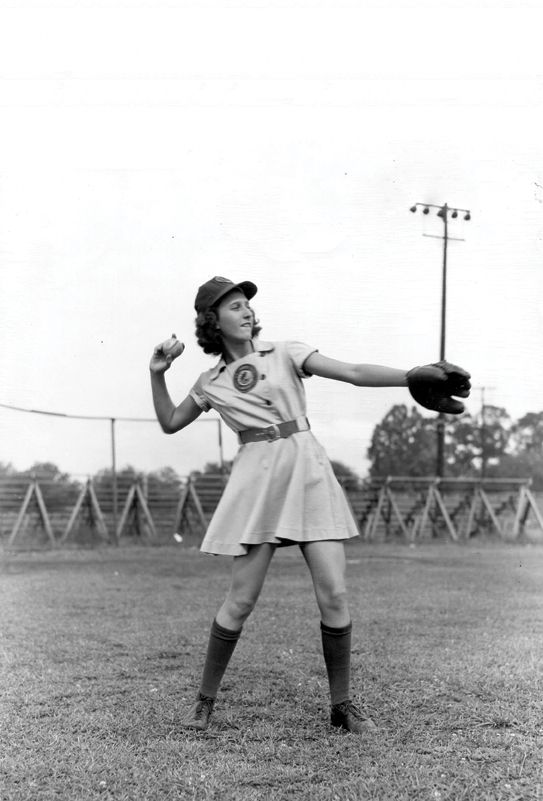
1947: Delores “Dolly” Brumfield White, fifteen, joins the South Bend (Indiana) Blue Sox of the All-American Girls Professional Baseball League
If you’d rather not make a uniform but would like an authentic reproduction there is a company that is the official licensee of the AAGPBL. Uniforms made by K & P Weaver can be found on their website.
Sewn or purchased, batter up and wear your smile, because “there’s no crying in baseball!”
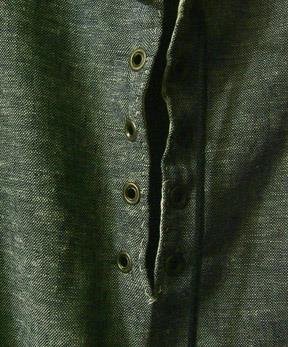
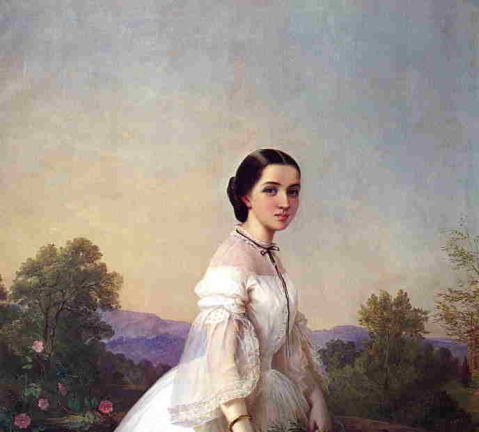
Leave a comment